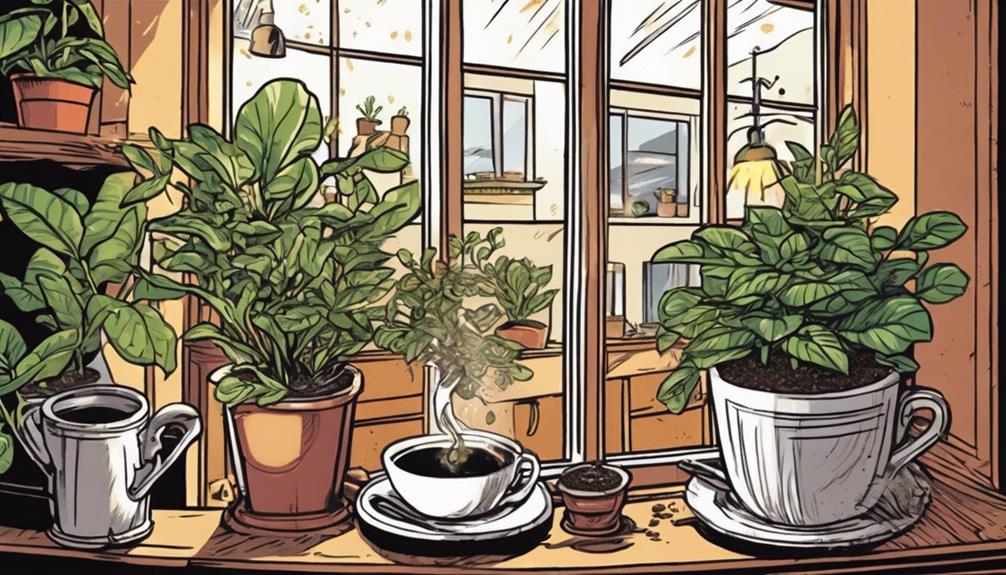Improve the health of your plants by spreading coffee grounds around them. These grounds contain vital nutrients that boost soil quality and promote plant health. Many garden plants benefit from using brewed coffee grounds. For plants that thrive in acidic soil like azaleas, it is best to use roasted unbrewed grounds. Remember to apply a thin layer to prevent clogging and mix them into the soil or compost. Dilute the grounds for better absorption and allow them to settle before watering. Additionally, coffee grounds act as a natural pest repellent. Keep trying different methods to discover what works best for your plants!
Key Takeaways
- Apply thin layers around acid-loving plants for optimal nutrient absorption.
- Mix coffee grounds with soil or compost to enhance plant nourishment.
- Dilute grounds in water, strain, then water plants for best results.
- Avoid waterlogging by ensuring soil is moist but not saturated.
- Regularly monitor soil pH levels to prevent acidity fluctuations.
Benefits of Using Coffee Grounds
Enhancing your plant's growth and health, using coffee grounds offers numerous benefits for your garden. When adding coffee grounds to your soil, you're providing essential nutrients like nitrogen, potassium, and phosphorus, which work to improve soil quality and promote plant vitality. These grounds act as a natural fertilizer, aiding in the healthy growth of your plants.
Moreover, the use of coffee grounds helps in retaining moisture within the soil, reducing the frequency of watering needed. This benefit not only saves you time but also guarantees that your plants receive adequate hydration. Additionally, coffee grounds can act as a natural repellent against pests such as slugs and snails, safeguarding your plants from potential damage.
Furthermore, incorporating coffee grounds into compost piles can accelerate the decomposition process, resulting in the creation of nutrient-rich soil that's highly beneficial for your plants. By utilizing coffee grounds in your garden, you're fostering a thriving and sustainable environment for your plant life.
Types of Plants for Application
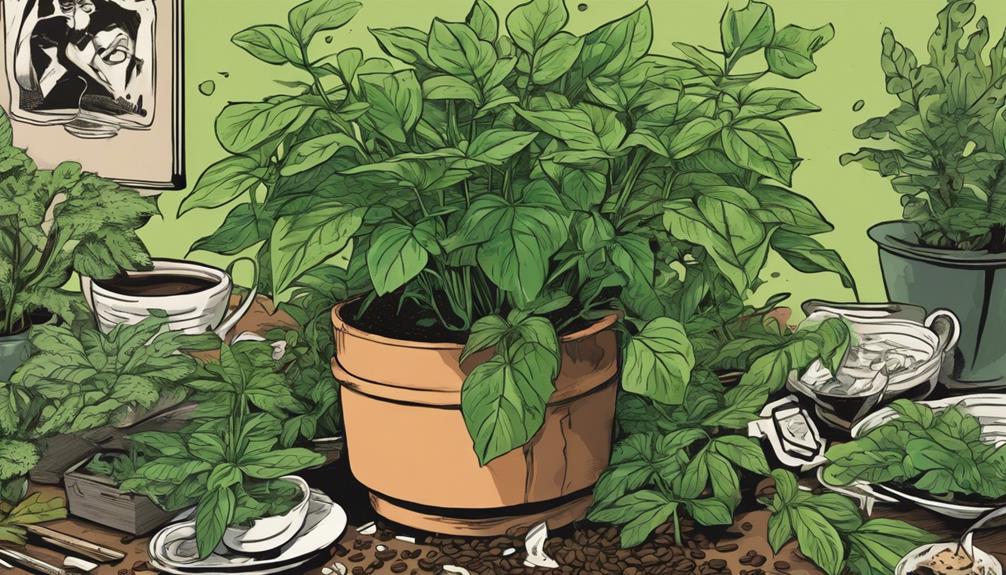
When choosing plants for applying coffee grounds, consider those that benefit from acidic soil like azaleas and blueberries.
Vegetables such as tomatoes and peppers also thrive with coffee ground additions.
Plants needing nitrogen-rich soil, like leafy greens, respond positively to coffee ground application.
Plant Selection
For most garden plants, using brewed coffee grounds is highly recommended. However, when it comes to acid-loving plants like azaleas, it's best to reserve roasted but unbrewed grounds.
Blueberries, on the other hand, greatly benefit from the acidity that coffee grounds provide. If you have vegetable patches, using composted grounds would be the most suitable option.
It should be noted that different plants have specific preferences when it comes to the application of coffee grounds. Some may thrive with a light sprinkling, while others might require a more generous amount.
Understanding the needs of your plants is key to maximizing the benefits of coffee grounds. By selecting the right plants for coffee ground application based on their preferences, you can foster a thriving and healthy garden that reaps the rewards of this natural fertilizer.
Suitable Applications
Coffee grounds can be applied to a variety of plants in your garden to provide them with beneficial nutrients and acidity. Plants like azaleas, blueberries, rhododendrons, and those that thrive in slightly acidic soil benefit greatly from the addition of coffee grounds.
Vegetables such as tomatoes, peppers, and carrots can also benefit from the nutrients found in coffee grounds. Flowers like hydrangeas and camellias are known to thrive when coffee grounds are added to the soil.
It should be noted that coffee grounds should be avoided for plants that prefer alkaline soil conditions, as well as succulents and cacti that are sensitive to excess moisture.
When applying coffee grounds, consider incorporating them into your compost pile to enhance the nutrient content and soil pH for your plants' best growth. Remember to always check the specific needs of your plants before adding coffee grounds to make sure they'll benefit from this natural fertilizer.
Plants Unsuitable for Coffee Grounds

Certain plants in your garden may not thrive when coffee grounds are applied directly to them. Tomato plants and bell peppers, for instance, don't respond well to the direct application of coffee grounds. These plants prefer a more balanced pH level, and the acidity of coffee grounds may hinder their growth.
Additionally, it's advisable to avoid using coffee grounds directly on vegetable gardens as they can have negative effects on plant development. Plants that enjoy alkaline soil conditions, such as roses and chrysanthemums, may not benefit from the acidity of coffee grounds.
It's essential to be mindful of the specific needs of each plant in your garden to ensure their best growth. Experimenting with coffee grounds in weed-prone areas might be a better alternative, as they could potentially assist in controlling unwanted plants without harming your beloved crops.
Proper Usage of Coffee Grounds
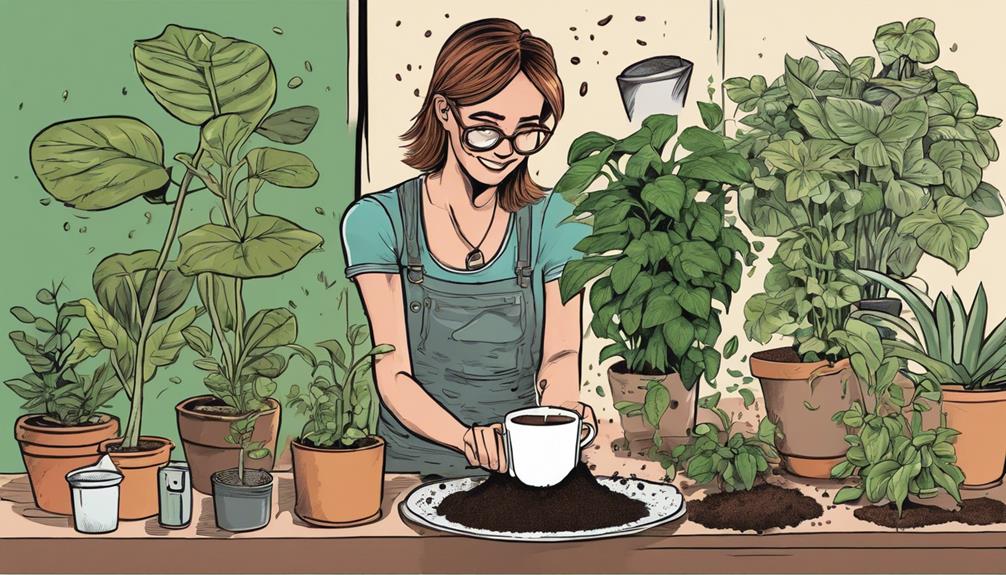
When utilizing coffee grounds in your gardening practices, make sure to apply a thin layer around acid-loving plants for maximum benefits.
Here are some important tips for the proper usage of coffee grounds:
- Avoid Thick Layers: To prevent water blockage in the soil, it's vital to refrain from creating thick masses of coffee grounds around your plants. A thin layer is all you need to reap the benefits without causing any harm to your garden.
- Mixing Options: Coffee grounds can be directly mixed into the soil at the base of your plants or incorporated into compost for enhanced plant nourishment. Experiment with different methods to see what works best for your garden.
- Blend for Growth: When planting new vegetation, consider blending coffee grounds with the existing soil. This practice can promote enhanced growth by providing the plants with essential nutrients over time.
Tips for Effective Application
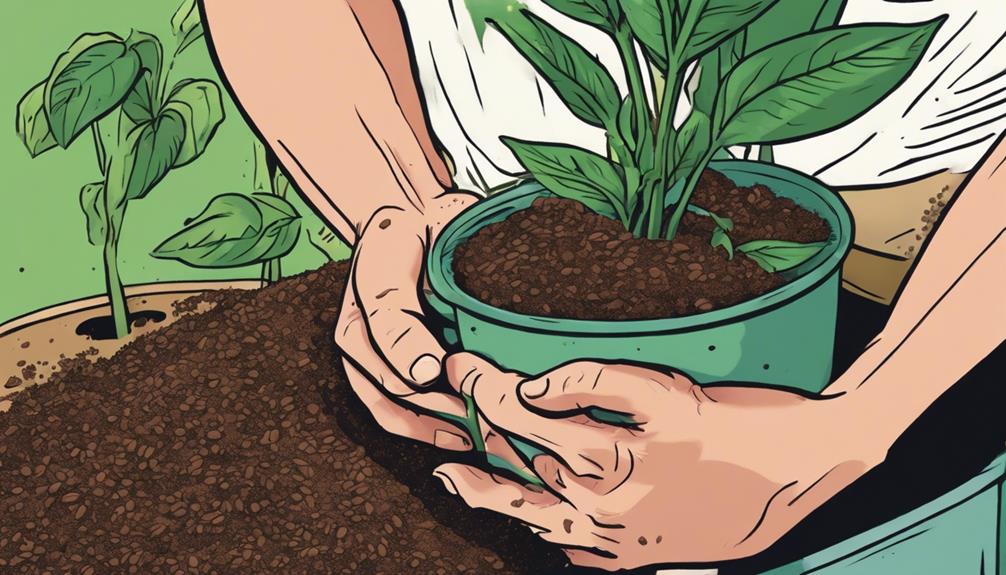
When applying coffee grounds to your plants, remember to:
- Dilute them properly
- Consider the brewing time
- Water your plants effectively
These points will help guarantee that your plants receive the benefits of coffee grounds without causing any harm.
Proper Dilution Ratio
To maximize the efficient application of coffee grounds to your plants, follow the recommended dilution ratio of 1 cup of grounds to 2.5 gallons of water. By diluting the coffee grounds properly, you secure that your plants receive the right amount of nutrients without overwhelming them.
Here are some tips for efficient application:
- Allow Mixture to Sit: Let the coffee ground mixture sit for up to 3 days to allow the nutrients to release fully, enhancing its efficiency as a liquid fertilizer.
- Strain Before Transferring: Before pouring the mixture into a watering can, make sure to strain it to remove any solid particles. This step prevents clogging of the watering can's spout and guarantees even distribution.
- Water Until Moist: When watering your plants with the diluted coffee ground solution, make sure the soil is moist but not waterlogged. This method helps in providing essential nutrients to your plants without causing root rot.
Remember to only use dried coffee grounds for best results, avoiding excess moisture introduction to your plants.
Brewing Time Consideration
Allowing your coffee grounds to steep for different lengths of time can greatly impact the acidity levels, influencing the nutrient content for your plants.
Longer steeping times result in higher acidity levels, while shorter steeping times lead to milder pH levels in the coffee grounds.
It's vital to adjust the steeping time based on the acidity preference of your plants. Consider the type of plant you're fertilizing and its tolerance to acidity when determining the steeping time for your coffee grounds.
Experimenting with various steeping times can help you find the best acidity level that suits your plants' needs. Remember that different plants have varying pH level requirements, so it's important to tailor the steeping time to meet these specific needs.
Watering Technique Recommended
For effective application of the coffee ground solution, make sure you water your houseplants once a week to promote proper nutrient absorption.
Implement the following watering technique tips to guarantee your plants thrive:
- Avoid Overwatering: Especially during the fall and winter seasons, be cautious not to saturate your plants. Overwatering can lead to waterlogging and root rot, hindering nutrient absorption.
- Apply Sparingly: When using coffee grounds, sprinkle them lightly onto the soil surface. Avoid excessive amounts as they can compress the soil and create drainage issues, affecting nutrient uptake.
- Use the Right Amount: Proper watering practices are essential in preventing water penetration problems and ensuring your plants receive the maximum benefits from the coffee ground solution. Finding the right balance will help maintain the health and vigor of your indoor garden.
Using Coffee Grounds for Houseplants

Consider mixing 1 cup of dry coffee grounds with 2.5 gallons of water to create a fertilizer solution for your houseplants. Let the mixture sit for up to 3 days to ensure proper infusion.
Afterward, strain the solution before transferring it to a watering can for easy application. When watering your houseplants, use the coffee ground solution until the soil is moist but not waterlogged.
Remember to only use dried coffee grounds for best results in fertilizing your houseplants. By following these steps, you can provide your indoor plants with a nutrient-rich boost that can promote healthy growth.
This natural fertilizer can be a great way to recycle your used coffee grounds while benefiting your houseplants at the same time. Show your green friends some love by treating them to this simple but effective coffee ground solution!
Key Factors for Success
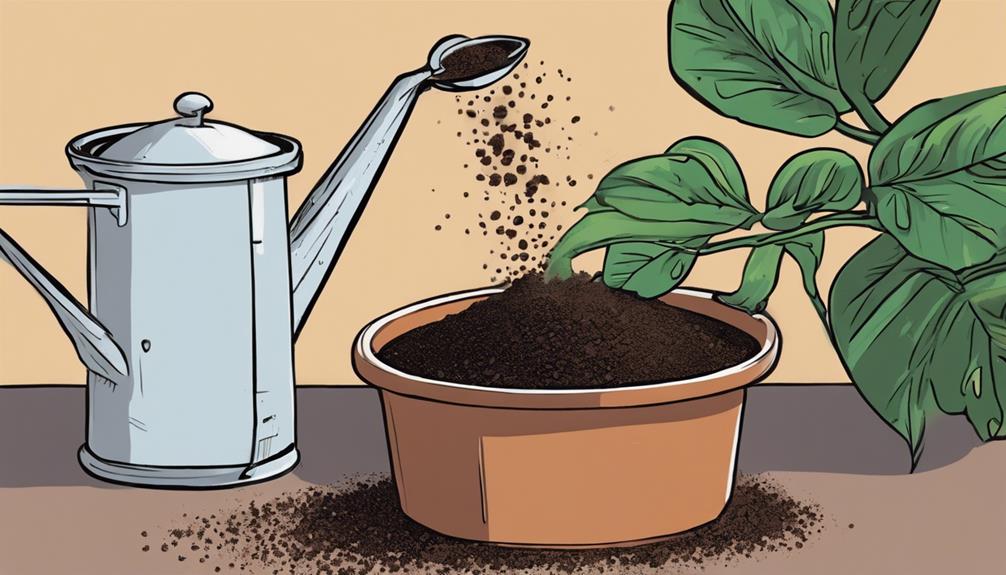
To ensure successful utilization of coffee grounds for your plants, pay attention to these key factors that can impact their effectiveness and your plant's health.
- Coffee Grounds Good for Important Nutrients:
Coffee grounds are packed with important nutrients like nitrogen, potassium, magnesium, and calcium, which are crucial for robust plant growth and development.
- Watch Out for Soil Acidity Issues:
Use dried coffee grounds to prevent soil acidity problems in your plants. This precaution is necessary to maintain a healthy growing environment for your green friends.
- Enhance Plant Fertilization:
For best results, choose pure black coffee grounds without any additives like milk or sweeteners. This will improve the fertilization process, providing your plants with the necessary nutrients they need to thrive.
Effects on Soil Ph Levels
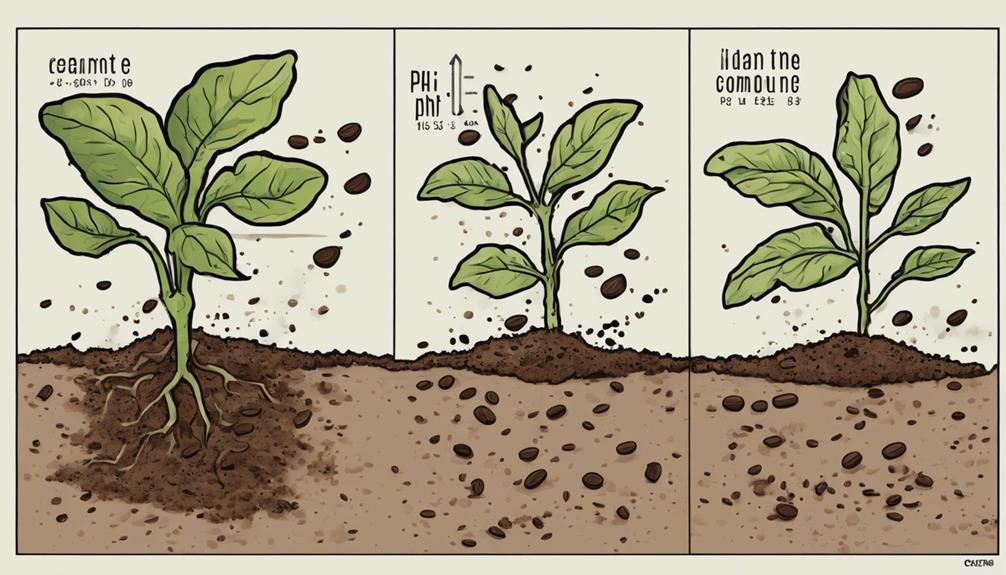
Maintaining the proper soil pH levels is necessary when incorporating coffee grounds into your gardening routine. Coffee grounds have a slightly acidic pH ranging from 6.5 to 6.8, which can aid in balancing the soil pH levels.
However, it's important to be cautious as fresh coffee grounds have the potential to increase soil acidity excessively, negatively impacting plant growth. To prevent pH fluctuations, it's recommended to use pure black coffee grounds without any additives like milk or sweeteners.
When adding coffee grounds to potting soil, they can gradually help improve the overall pH range, promoting better plant health. Regularly monitoring soil pH levels through soil tests is essential to ensure that the acidity levels remain within the best range for your plants' well-being.
FAQs About Coffee Grounds

When applying coffee grounds to your plants, it's important to address common questions about their usage. One common question is whether coffee grounds are acidic or alkaline. While fresh coffee grounds are acidic, they actually become more neutral as they break down, making them suitable for a wide range of plants. Another question is how much coffee grounds to use, and the answer depends on the size and type of plant. To maximize your garden with coffee grounds, experiment with different amounts and observe how your plants respond. You may find that a little goes a long way, or that certain plants thrive with regular applications.
- How often should I water my houseplants with used coffee grounds?
Watering houseplants with a coffee ground solution can be done once a week for best growth. This frequency allows the plants to benefit from the nutrients without risking overwatering.
- Can I use coffee grounds for acid-loving plants like gardenias?
Yes, coffee grounds are suitable for a variety of plants, including acid-loving ones like gardenias. The acidity of the grounds can help these plants thrive and maintain healthy growth.
- What are proper watering practices to follow when using coffee grounds?
Proper watering practices are essential when using coffee grounds to prevent water penetration problems. It's safe to continue using coffee ground fertilizer during fall and winter, but be cautious of overwatering to avoid any issues with the plant's health and growth.
Benefits of Homes & Gardens Newsletter
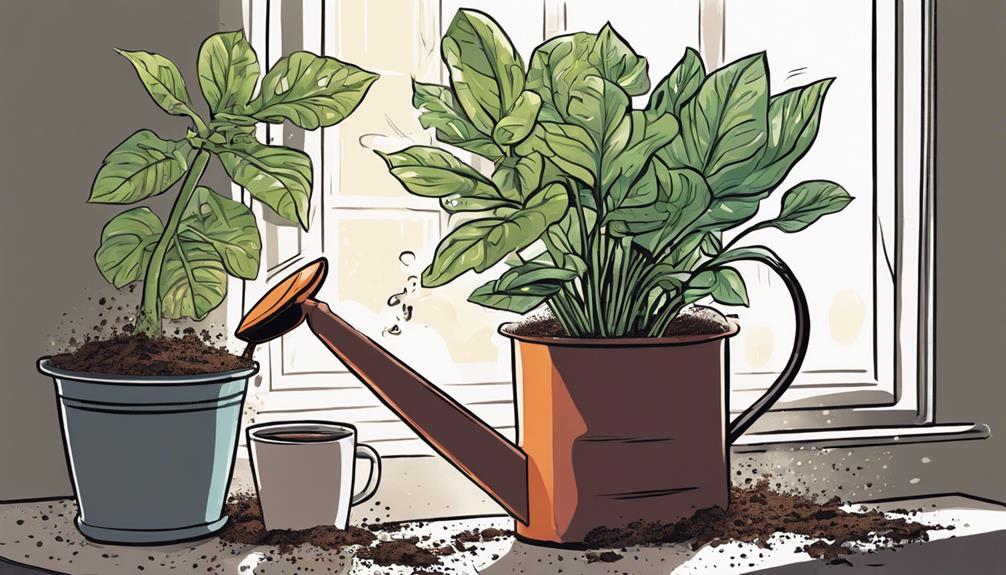
Want to elevate your home and garden game?
The Homes & Gardens newsletter offers expert design tips, celebrity home insights, and exclusive offers.
Subscribe now to stay in the loop with the latest trends and make your space shine!
Newsletter Content
Stay informed and inspired with our Benefits of Homes & Gardens Newsletter, delivering expert design and gardening advice directly to your inbox.
Here's what you can expect from subscribing:
- Expert Advice: Receive valuable tips on using spent coffee grounds to benefit your indoor plants. Learn how this simple practice can be good for plants and enhance your gardening experience.
- Trend Updates: Stay in the loop with the latest trends in celebrity homes and shopping for your living spaces. Get insights on how to incorporate these trends into your own home and garden design.
- Exclusive Offers: Access special news and offers from our trusted partners, providing you with unique opportunities to enhance your living environment.
Be sure to review our Privacy Policy to understand how your information is handled and protected.
Subscription Benefits
Get expert design advice, decorating ideas, and gardening tips when you subscribe to the Homes & Gardens newsletter. By signing up, you'll benefit from a wealth of knowledge on composted coffee grounds and using coffee grounds to enhance your plant's growth.
Adding coffee grounds to your gardening routine can greatly benefit your plants by enriching the soil with essential nutrients. Subscribers also stay informed on the latest trends in celebrity homes and receive curated shopping selections, allowing you to stay ahead in home decor and design.
Additionally, you'll gain access to exclusive news and offers from trusted partners in the industry, ensuring you're always in the loop with the best deals and updates. Don't miss out on the opportunity to elevate your gardening game and home decor skills with the Homes & Gardens newsletter subscription.
Subscribe today to start reaping the benefits of expert advice and insider tips!
Frequently Asked Questions
Can I Just Sprinkle Coffee Grounds on Plants?
Yes, you can sprinkle coffee grounds around your plants for improved soil quality and essential nutrients. Remember to avoid thick layers to prevent water blockage and mix with compost for balanced enrichment. It can also repel pests.
Do You Put Coffee Grounds on Plants Wet or Dry Soil?
You should put coffee grounds on plants with dry soil. Wet soil can cause clumping, affecting aeration and nutrient release. Dry grounds are easier to distribute evenly, maintaining soil structure and preventing moisture-related issues.
How to Add Coffee Grounds to Potted Plants?
When adding coffee grounds to potted plants, mix dry grounds into the soil for nutrients. Sprinkle a thin layer on top of soil. Avoid wet grounds to prevent mold. Water plants after application for nutrient absorption.
Which Plants Do Not Like Used Coffee Grounds?
Plants like roses, chrysanthemums, succulents, cacti, those prone to fungal diseases, seedlings, and plants needing well-draining soil don't favor used coffee grounds. Keep these in mind for best plant health.
Conclusion
Now that you know the benefits of using coffee grounds on your plants, go ahead and give it a try!
Remember, coffee grounds can help improve soil health, ward off pests, and promote growth in a variety of plants.
So grab your morning brew, save those grounds, and watch your garden flourish in a whole new way.
Happy planting!
